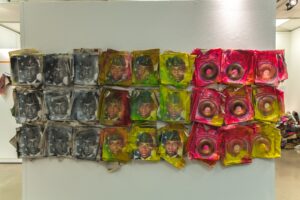
Artist’s Statement
“We are living in a fake world; we are watching fake evening news. We are fighting a fake war. Our government is fake. But we find reality in this fake world. So our stories are the same; we are walking through fake scenes, but ourselves, as we walk through these scenes, are real.”
– Haruki Murakami
As a veteran, I see the present through the lens of our complicated and contradictory history of warfare. I aim to create art that is interactive, visually appealing, and intellectually challenging, and I try to pose questions such as: What is the difference between a piece of art and a monument or memorial? Or, what do we collectively choose to remember and what do we allow ourselves to forget?

Marlon Triptych, 2015
Marlon Triptych, for example, is the story of war and war profiteering in the age of mass marketing and hyper-consumerism. From left to right, the imagery of the dead soldier’s black-and-white file photo is jazzed up with vivid, living colors so that the man becomes a myth and the myth, in turn, becomes a brand, a marketing gimmick, a trick used to sell consumer goods like sweet and sugary glazed donuts.
The soldier is real. Marlon Jackson emigrated to the U.S. from Jamaica, enlisted in the Army, trained as a combat engineer, and died when a roadside bomb exploded in Iraq on Veterans Day 2003. He was 25 years old.
In 2014, Krispy Kreme Doughnuts launched a campaign to celebrate Veterans Day by offering a free doughnut and a small coffee to all veterans. The poster of the glazed doughnut with the red, white, and blue strips emanating from the center was used to market the holiday promotion. And, thus, like thousands of other American retailers, Krispy Kreme Doughnuts found a way to exploit the experience of war for the purpose of business.
In more formal terms, my work explores the tension between imagery and text, between the personal and the universal, and between the familiar and the unexpected. In Marlon Triptych the images of the soldier and the doughnut are plastered on top of a messy pile of unreadable copies of the New York Times. By making a canvas of the same newspaper whose editors later apologized for their mistakes in reporting on Iraq’s weapons of mass destruction, I aim to link the fate of the dead solider to the bad reporting that helped give start to the war in which he died. And by nailing the 27 panels directly into the wall in a somewhat non-linear, sloppy fashion, my aim is to comment on Krispy Kreme’s exploitation of Veterans Day by disrupting the viewer’s expectations about the proper way to display images of fallen American soldiers.
Finally, the obvious reference to Warhol’s Marilyn Diptych is meant to be contradictory and even troubling. On the one hand, my work is inspired by his diptych and isn’t it true that imitation is the sincerest form of flattery? On the other hand, by replacing his imagery of an iconic actress with the file photo of a dead soldier, I aim to question his intentions and, by extension, those of pop art in general. Does Warhol use Marilyn’s image to critique consumer culture or is he cynically exploiting her memory for his own consumer purposes? And then again, who are the real heroes of American pop culture: the beautiful actress or the dead soldier?
